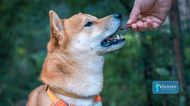Holiday Food Hazards: The Complete Guide to Keeping Dogs Safe During Winter Celebrations
Posted by Volhard Dog Nutrition on Oct 16th 2025
The holidays are a time of joy, togetherness, and, of course, plenty of delicious food. From the sweet treats of Halloween to the rich feasts of Thanksgiving and the festive spreads of Christmas, our tables are filled with seasonal favorites.
Many common holiday ingredients, from chocolate and raisins to turkey drippings and nut mixes, can be harmful, or even toxic, to dogs. And because celebrations often mean guests, leftovers, and overflowing plates, it’s easy for a curious pup to sneak a bite of something they shouldn’t.
You’ll learn which festive foods are unsafe, how to prevent accidental indulgences, and what steps to take if your dog does get into trouble. With the right knowledge and a little preparation, you can keep your dog safe and healthy while enjoying every moment of the holidays together.
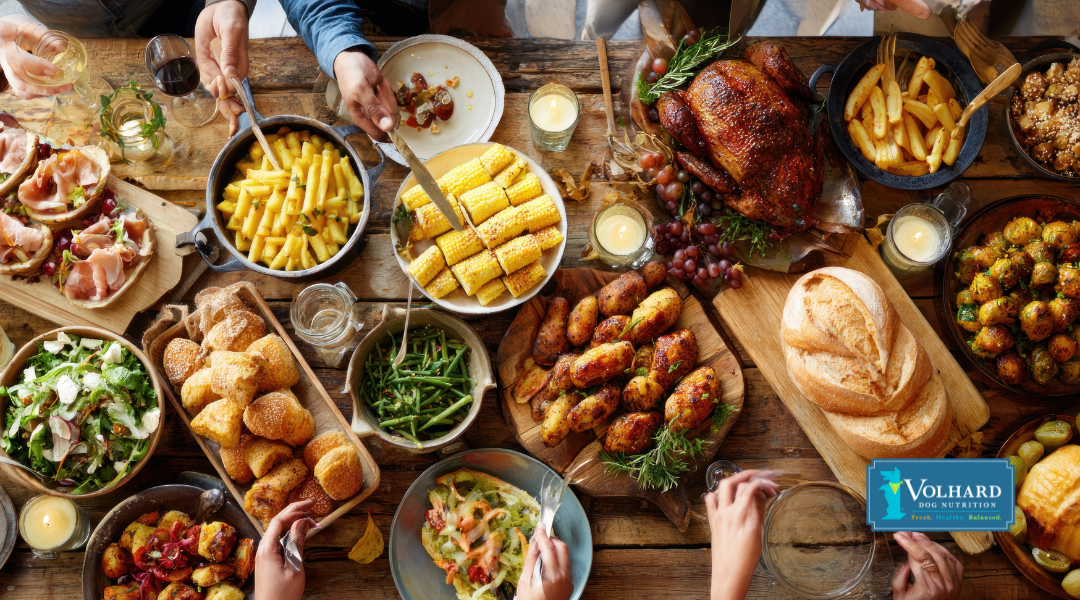
Why Holiday Foods Pose Hidden Risks to Dogs
The holiday season is a time for sharing, family gatherings, festive meals, and the joy of including every member of the household, dogs included. It’s natural to want your pup to join in the fun, after all, our dogs are part of the celebration.
But what’s tasty and harmless to us can have very different effects on a dog’s body. Rich, sugary, or heavily seasoned dishes may cause stomach upset, while other common holiday ingredients can lead to more serious health concerns such as seizures. With so much food around, and guests who may not know the rules, the risk of accidental indulgence is higher than at any other time of the year.
Keeping your dog safe doesn’t mean leaving them out, it simply means celebrating with awareness. By knowing the risks and setting some thoughtful boundaries, you can make sure your furry friend enjoys the festivities right alongside you, without putting their health at stake.
Common Holiday Foods That Are Toxic to Dogs
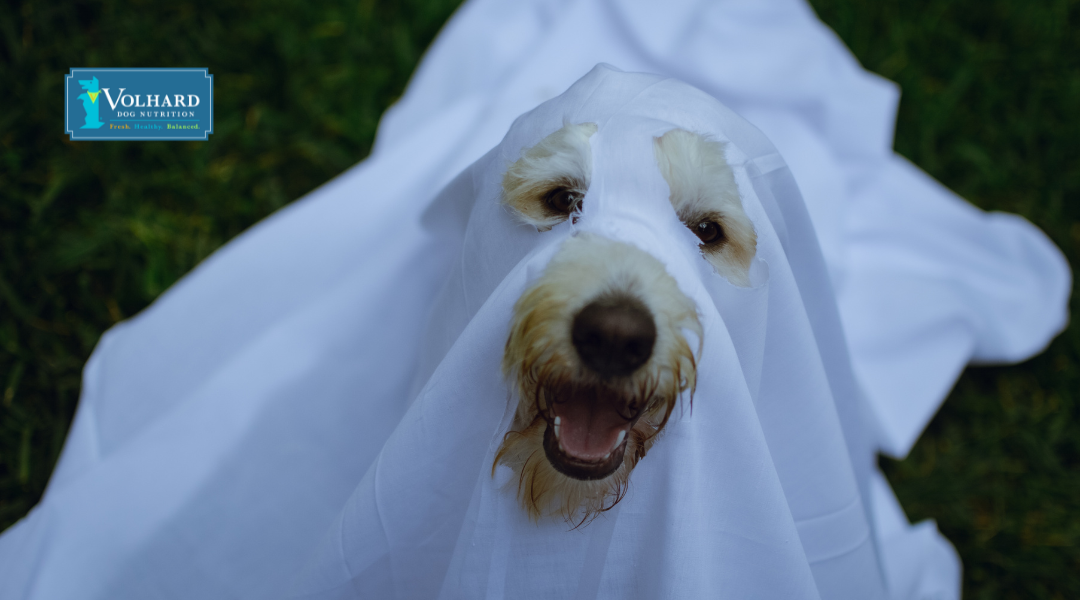
Halloween
Chocolate Candy and Cocoa Treats
Chocolate is one of the most well-known hazards for dogs, especially around Halloween when candy bowls are everywhere. Dark, baking, and even some milk chocolates, contain theobromine and caffeine, stimulants that dogs can’t metabolize well. These compounds can cause everything from mild stomach upset to serious cardiac and neurological problems, depending on how much was eaten and the size of your dog.
It’s not just the chocolate itself but the temptation: a curious snatch from a bowl, or leftover pieces dropped on the floor. During Halloween, when there are more people and more sweets around, those chances multiply.
Prevention tip: Keep all chocolate and cocoa treats well out of reach. Store in sealed containers, on high shelves and/ or closed cabinets. If you want to let your dog feel included, offer a dog-safe treat you trust instead of letting them sample yours.
Sugar-Free Candy With Xylitol
Many “sugar-free” candies seem like a safer choice for humans but can be extremely dangerous for dogs, especially ones sweetened with xylitol. Xylitol causes a rapid release of insulin in dogs, which can lead to hypoglycemia (dangerously low blood sugar), and in severe cases, liver failure. Even small amounts matter, so one candy piece is enough to cause serious harm in a small dog.
Because quantity and sweetness can be deceiving, it’s important to be extra cautious during Halloween. Candy wrappers are sometimes brightly packaged or left unattended, and eager pups may chew through packaging trying to get to what’s hidden inside.
Prevention tip: Read labels carefully. If it says “sugar-free” or “no sugar added,” check whether xylitol (or other artificial sweeteners) is listed. Keep all sugar-free candies well-sealed and out of reach, and educate guests—many people don’t realize how dangerous xylitol is for dogs.
Candy Wrappers and Packaging Hazards
Even candy without dangerous ingredients can pose risks if the packaging is accessible. Dogs may chew or swallow wrappers, foil, or bits of cellophane. These can cause choking, blockages in the digestive tract, or cuts in the mouth or throat. Around Halloween, there are more people handing out candy, more discarded wrappers, and more distracted hosts, which means more risk.
Candy wrappers often contain traces of chocolate, sugar, gum, and other sticky residues. So even if a wrapper seems benign, licking or ingesting part of it can introduce the same hazards as eating the candy itself.
Prevention tip: Dispose of wrappers immediately and thoroughly. Use covered trash cans, clean up after trick-or-treaters, and supervise dogs, especially inquisitive ones. Consider keeping your dog away from high-traffic candy zones to reduce temptation.
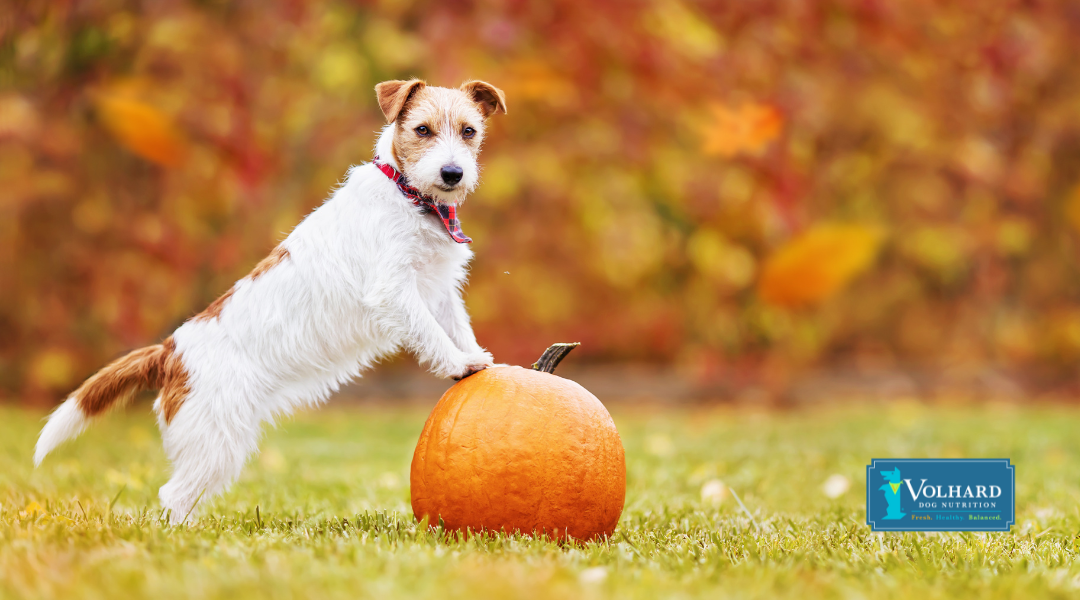
Thanksgiving
Turkey Skin, Fat, and Cooked Bones
The turkey may be the star of your Thanksgiving table, but not all parts are safe for your dog. While plain, lean turkey muscle meat can be a healthy protein source, the skin and fatty trimmings of a cooked Thanksgiving turkey are loaded with oils, butter, and seasoning that can overwhelm a dog’s digestive system, sometimes triggering painful pancreatitis.
Even more concerning are cooked turkey bones. Once roasted, they become brittle and can splinter, creating sharp shards that may cause choking, internal injuries, or dangerous blockages. For dogs who want to “join the feast,” stick to unseasoned turkey meat and skip the risky scraps.
Stuffing and Casseroles With Onions
No Thanksgiving spread feels complete without stuffing or rich casseroles, but these dishes often contain onions, scallions, or leeks—all members of the allium family, which are toxic to dogs. Even in small amounts, these ingredients can damage red blood cells and lead to serious health complications.
Combined with heavy butter, salt, and seasonings, stuffing and casseroles are simply not worth the risk for your pup. If you’d like your dog to enjoy something alongside you, a spoonful of plain pumpkin or a bit of steamed sweet potato is a much safer option.
Rich Desserts and Nut Mixes
From pumpkin pie to candied yams to festive nut bowls, Thanksgiving desserts are often packed with sugar, spices, and fats that dogs struggle to process. Ingredients like nutmeg (commonly used in pies) can be toxic, while nuts such as macadamias are known to cause weakness and neurological symptoms in dogs.
Even “safer” nuts can present choking hazards or contribute to gastrointestinal upset. Dogs don’t need sugary sweets to feel part of the celebration, better to treat them with a dog-friendly pumpkin snack.
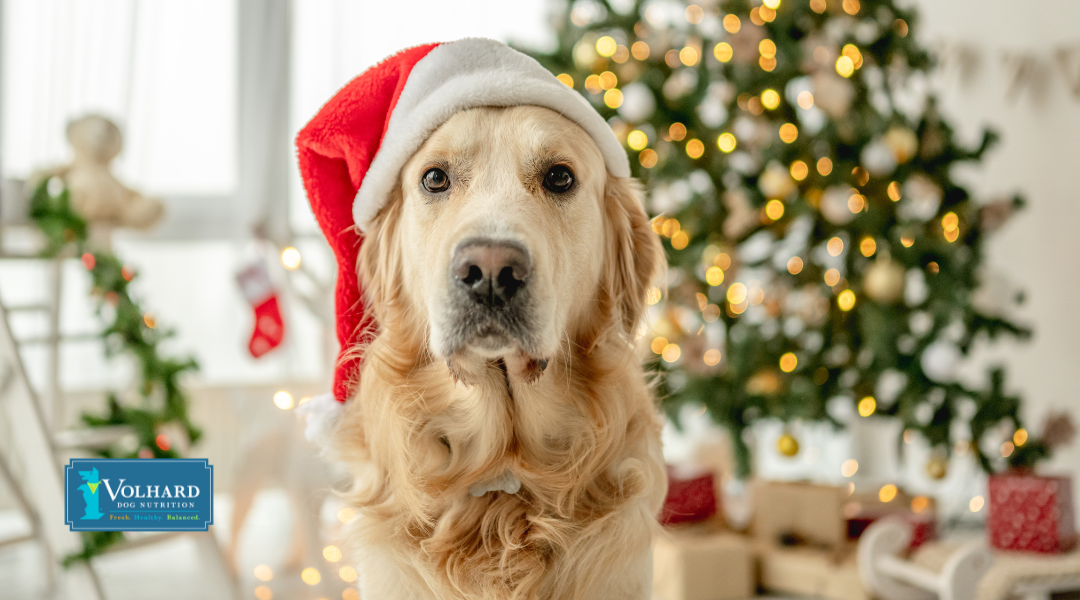
Christmas & Winter Celebrations
Raisins, Currants, and Fruitcake
Fruitcake may be a holiday classic, but it’s one of the most dangerous foods for dogs. Raisins, currants, and grapes, common in fruitcake, mince pies, and other Christmas treats are highly toxic to dogs. Even small amounts can cause severe kidney damage, and the reaction is unpredictable: some dogs may fall ill from a single raisin.
Because these ingredients are often baked into festive desserts, it’s easy for pet parents to overlook the risk. The safest choice is to keep all fruitcakes, puddings, and raisin-filled dishes well out of reach.
Alcohol-Infused Desserts and Eggnog
From brandy-soaked puddings to rum balls and spiked eggnog, alcohol often sneaks into holiday recipes. Dogs are far more sensitive to alcohol than humans, and even small amounts can cause dangerous drops in blood sugar, blood pressure, and body temperature.
Desserts that use alcohol also tend to be rich in fat and sugar, making them doubly risky. Keep in mind that eggnog, even without alcohol, often contains cream, sugar, and spices that aren’t kind to canine stomachs.
Leftover Bones and Table Scraps
The end of a big Christmas meal often means platters of leftovers and discarded bones—but sharing them with your dog can spell trouble. Cooked bones from roasts, ham, or poultry become brittle and splinter easily, risking choking or serious internal injuries.
Meanwhile, salty gravies, and heavily seasoned scraps can trigger gastrointestinal upset or more serious conditions like pancreatitis. While it may feel festive to let your dog “clean up” after dinner, keeping them on their balanced diet is the healthier, and safer, way to celebrate.
Other Festive Treats and Ingredients That Can Cause Discomfort
Fatty Meats and Pan Drippings
Holiday meals often leave behind rich drippings, buttery sauces, and fatty cuts of meat. While tempting to pour over kibble or sneak under the table, these high-fat foods can overwhelm a dog’s digestive system.
In some cases, they trigger pancreatitis, a painful and potentially serious inflammation of the pancreas. Symptoms may include vomiting, diarrhea, lethargy, or abdominal pain. Even a small indulgence can be enough to cause discomfort, so it’s best to avoid offering fatty leftovers altogether.
Dairy-Rich Dishes
From cheesy casseroles to whipped cream-topped desserts, dairy products play a starring role in many holiday recipes. But most adult dogs are lactose intolerant, meaning their digestive systems don’t produce enough of the enzyme needed to break down lactose in milk.
The result? Gas, bloating, and diarrhea. While a tiny taste of cheese might not bother every dog, rich dairy dishes loaded with butter, cream, and seasoning are best kept off their menu. Instead, opt for dog-safe treats that won’t leave their stomach in distress.
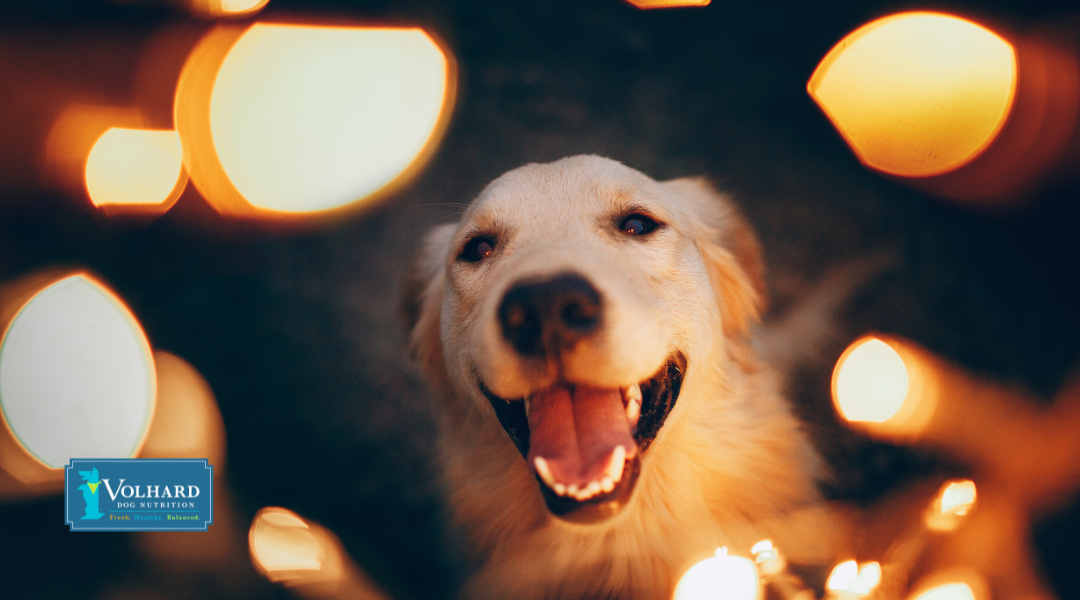
Prevention Tips for a Safe Holiday Season
Setting Boundaries at the Dinner Table
The holidays bring overflowing plates, curious dogs, and well-meaning guests who may not realize what foods are unsafe. One of the simplest ways to prevent problems is by setting clear boundaries.
Teach your pup to stay in their own space during meals, or provide a cozy spot nearby with a chew or toy to keep them occupied. Don’t be afraid to gently remind family and friends not to slip your dog table scraps, it only takes one treat to cause harm. Consistency across the household ensures your dog feels included without being put at risk.
Safe Alternatives: Dog-Friendly Holiday Treats
Celebrating together doesn’t mean your dog has to miss out on the fun. Offer safe, festive alternatives so they feel part of the occasion. Plain pumpkin purée, a few bites of unseasoned turkey, or dog-friendly holiday biscuits are great options. By giving your pup their own holiday “menu,” you redirect their excitement away from the dinner table and toward something designed just for them.
Emergency Situations: What to Do if Your Dog Eats Something Harmful
Even with the best precautions, accidents can happen. If your dog manages to sneak food they shouldn’t, quick action makes all the difference.
First, stay calm and try to identify what and how much they ate. Watch for symptoms like vomiting, diarrhea, lethargy, or restlessness, but don’t wait for signs to appear if you know they’ve ingested something toxic.
Call your veterinarian immediately or contact an emergency pet poison hotline for guidance. Having your vet’s number handy and knowing the nearest emergency clinic will give you peace of mind, so you’re prepared to act swiftly if needed.
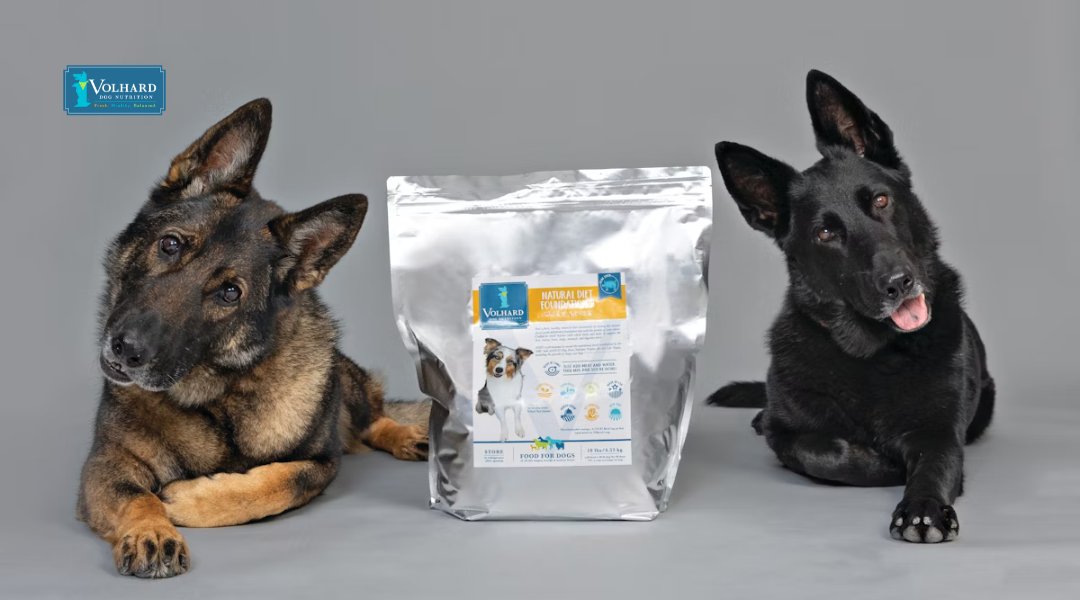
Make the Holidays Joyful and Safe by Choosing Volhard Dog Nutrition
Volhard’s whole food diets and targeted supplements can help your dog eat happily and feel their best.
For more advice on dog nutrition, health, and training, contact us and check out our other blogs, too!
Volhard Dog Nutrition and its expert canine nutrition coaches offer online consultations to help more dog parents discover why and how to feed their dogs the healthiest foods!
Speaking to a Volhard canine nutrition coach will help you understand the inseparable relationship between healthy food, a healthy body, and a healthy mind.
If you want to contact one of our Volhard canine nutrition coaches, you can do so by utilizing our Live Chat feature or scheduling a consultation.
References:
Gwaltney-Brant, S. M. (2013). Xylitol toxicosis. Veterinary Clinics of North America: Small Animal Practice, 43(5), 981-993.
Steiner, J. M. (2010). Canine pancreatitis. Veterinary Clinics of North America: Small Animal Practice, 40(2), 213-235.
Winkel, K. D., & Klausner, J. S. (2006). Chocolate toxicosis in dogs: a review of 221 cases (1985-1992). Journal of the American Veterinary Medical Association, 208(9), 1447-1448.
Zuberbühler, B., & Jeffery, N. D. (2006). The pathophysiology of grape and raisin toxicity in dogs. Veterinary Toxicology Journal, 18(2), 121-128.

